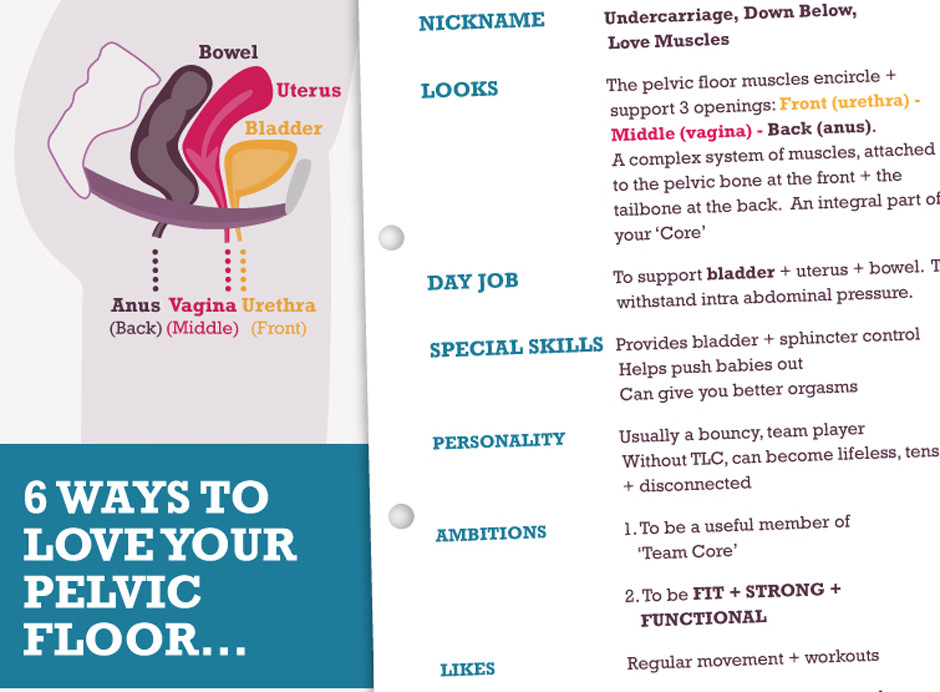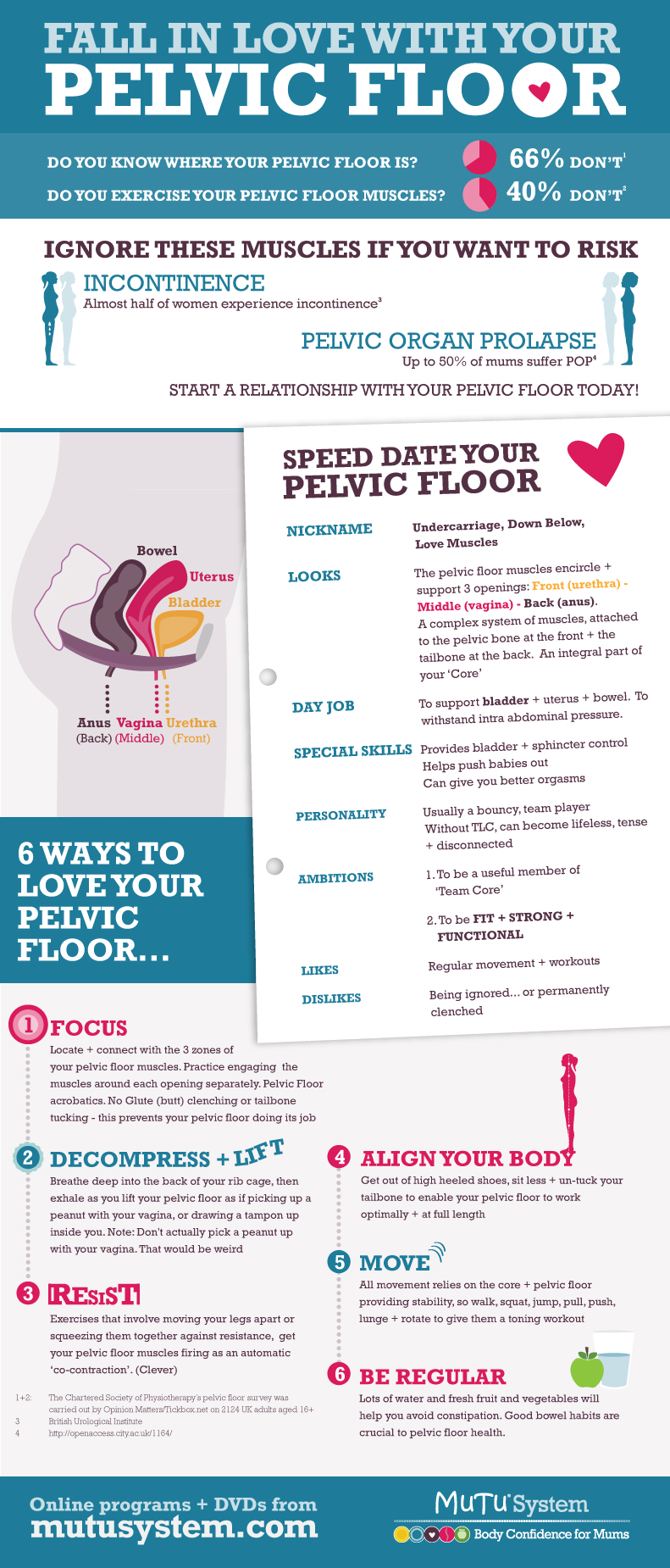The following is a special post just for women from contributor Wendy Powell of MuTu System. Boys, avert your eyes until next time…
Doing pelvic floor exercises is one of those things we‘re just supposed to know how to do.
Midwives, health professionals, doctors and fitness instructors ask “You are doing your pelvic floor exercise aren’t you?” and we’ll nod emphatically, whilst clenching our undercarriage like crazy to make up for lost time.
But do you know how to do pelvic floor exercises? I mean like, really? We feel we should know. Its our pelvic floor after all. We surely have some innate knowledge about how to exercise it. But if the extent of your instruction or knowledge to date, is to ‘squeeze like you’re trying not to wee’, then listen up for a little Pelvic Floor 101.
WHAT EXACTLY IS THE PELVIC FLOOR?
A complex system of muscles that make up the fleshy underside of your pelvis between your legs. From your pelvic bone at the front, through to your tailbone at the back, and from side to side between your sit bones, these muscles withstand pressure inside your pelvis, holding everything up in in its place as well as forming the muscular sphincters around your urethra, vagina and anus. It ain’t rocket science why you need these muscles to function well. Urinary and fecal continence, strong orgasms and preventing your insides from being outside, all being just a few of the fundamentals.
WHY DOES IT GET WEAK?
Vaginal childbirth quite clearly gives your pelvic floor quite a pounding. But the extra pressure and load of pregnancy, as well as shifts in your alignment, mean that even if you had a c-section leaving your pelvic floor relatively unscathed, you may still later experience weakness. Hormonal changes as we age, as well as lifetime alignment imbalances also affect our pelvic floor’s ability to function optimally.
Many women ‘lose touch’ with their pelvic floor after childbirth. That sounds odd, but a traumatic birth experience, pelvic floor damage or unhappiness with the way their pelvic and abdominal body parts look and feel, leads to a disconnect. This brain-to-muscle lack of communication can lead over time to a lack of awareness and function…and you need to get re-acquainted if its all going to work again.
HOW TO STRENGTHEN YOUR PELVIC FLOOR
1. BY FINDING IT
You can’t strengthen or work with a muscle your brain has stopped talking to. So the first stage is to get to know your undercarriage again.
A good position is to kneel astride a large bolster or pile of pillows. Shuffle your body weight so you are on your sit bones, not back on your tailbone. You may feel like you have to stick your butt out to get there (if your pelvis is habitually tucked), and grabbing the flesh of your butt cheeks and gently pulling the flesh back behind you can help you to get a feel for sitting forward on your pelvis, not back on your coccyx.
So now your pelvic floor is in direct contact with the bolster you’re kneeling astride. You can feel it because you’re sitting on it. Drop your shoulders, take the tension out of your upper body and shift your ribs back over your pelvis so your chest isn’t thrust out in front.
Close your eyes so you can focus on your breath and your body. Breathe in, allowing your ribs to expand sideways, relaxing your abdominal and pelvic floor muscles to allow the in-breath. Then exhale with with your lips only slightly parted and as you do, imagine you are picking up a grape with the opening of your vagina and drawing it up inside you. Another great visual is to imagine sucking smoothie through a straw…with your vagina as the straw. Think about all parts of your pelvic floor, so as well as focusing on the vagina, imagine you’re trying to stop yourself form farting, contracting and drawing in the muscle of your anal sphincter, and then, yes, imagine you’re trying to stop a wee, drawing in right at the front. All this is just about finding the muscles…
Always lift, draw up, suck up or whichever visual is working for you, on an exhale. And always relax (don’t push away, just let go) on the inhale. Practice isolating the urethra, (that’s the stopping the flow of wee one), the vagina and the anus, each on an exhale. The movements are never forceful but slow, focused and in time with your breath.
By spending a few quiet moments every day checking in on your pelvic floor, you will reconnect mind and body, rebuilding the natural reaction and function of engaging your pelvic floor as part of your core whenever you exert pressure – lifting, pushing, or straining.
2. BY RELAXING IT.
A tight muscle doesn’t make a strong muscle. Muscles that are hypertonic, or overtight, are the result of – probably unconscious – long term tension. Here’s how that might happen…
Maybe you always stand with your backside tucked under you, your buttocks clenched at a low level the whole time, flattening your bum. If you can visualize it, this means that the muscles that run from pubic bone, right underneath you to tailbone, are permanently shortened. Never able to function at full length, the muscles are tight and unable to stretch and contract as they should. This permanently shortened muscle is every bit as ineffective as an over-stretched or slack one.
Or maybe you HAVE been diligently doing your pelvic floor exercises. Kegels are taught as a squeeze, which can become so habitual it means you’re always hanging on to your pelvic floor, keeping the muscles tightened and shortened. Doing Kegels also very often means you also squeeze your buttock muscles, tucking underneath you and creating the effect described above.
So by all means find your pelvic floor with gentle lifts and squeezes (see above), but to be strong and functional, you have to let those muscles go too.
3. BY LETTING YOUR STOMACH MUSCLES RELAX
Maybe you’re used to sucking in your tummy a lot to make it appear flatter. First, sucking in your tummy is not engaging your core (more on what engaging your core actually means here). But importantly sucking it all in exerts huge pressure both upwards into your diaphragm, hindering full natural breathing, but also downwards, onto your pelvic floor. Learn to engage your core as a gentle but effective bracing to stabilize your body, but get used also to letting it go. Constantly or forcefully sucking in your abs will do nothing at all to strengthen your core… let it go!
4. BY MOVING IT
Working your pelvic floor is not all about kneeling or sitting with a faraway look on your face as you lift, squeeze or suck it up. Your pelvic floor’s job is to withstand pressure and keep everything in its place during movement, and the muscles are naturally triggered to work by that movement. Squatting in good technique, squeezing your legs together or pulling them apart – (especially against resistance, squeezing a ball or pillow, or using resistance bands for example), all these movements are a great workout for your pelvic floor! MuTu System programs include many of these exercises, focussing on engaging your pelvic floor during real upright movement, not just when sitting or lying still.
Change your sitting habits. Get up, walk more, think about a standing desk or at least take more breaks from your seat. The more your pelvic floor gets to move, in good alignment and at full muscle length (i.e. not tucked or over tight), the more functional it will become.
5. GETTING OUT OF HIGH HEELS
High heels, or indeed any shoes with a positive heel, pitch your body forward into a position that overworks and tightens the muscles at the fronts of your thighs and hips and puts strain on your knees. Your backside tucks under to compensate, and your pelvic floor is again compromised by the alignment of your body. Standing and walking in high heels is no good for your pelvic floor!
6. AND BY STRETCHING. EVERY SINGLE DAY
You know about finding muscles, engaging them, contracting and working them. But the need to stretch muscles that are over tight, is even more important if your body, including your pelvic floor, is to function at its best. The most important muscles to stretch to free up and align your pelvis and allow your pelvic floor muscles to work, are your calves, your hamstrings and your adductors (the insides of your thighs).
Take your time over your stretching, breathe steadily and focus on the areas of your body you’re working on. To achieve and maintain benefits form stretching it really does need to be a daily practice – grab a stretch as often as you can!
MuTu System programs incorporate all of these principles into the progressive phases of core work and stretching.
For more information on the MuTu System, click here. As always, InspiredRD readers get 15% off any MuTu System with the code “INSPIRED15″.
UK-based Mom of 2 Wendy Powell is founder of the internationally recognized and sought after MuTu® System program. She has accrued over 12 years experience, proven record and study in the pre and postpartum fitness industry. Connect with Wendy by signing up to receive information on the MuTu System website, on Facebook, Twitter + Pinterest. Programs can be downloaded online, or DVDs shipped internationally, all available from the website.
Previous posts by Wendy Powell:
How Better Alignment Helps Fix Diastasis Recti
Eat well to heal your diastasis recti – How good nutrition can help your body to close “The Gap”
2 Diastasis Recti Fixes that WON’T Work – And What Will
A Diastasis Expert Answers All of Your Questions
This post contains affiliate links.



[…] 10 Mommy Must-Haves via Delights & Delectables Leading Lady Nursing Bra Tanks via Itz Linz How To Do Pelvic Floor Exercises via Inspired RD My First Week of Motherhood via Back To Her Roots 3 Key Steps To Fast Post Baby […]
[…] How to do pelvic floor exercises […]